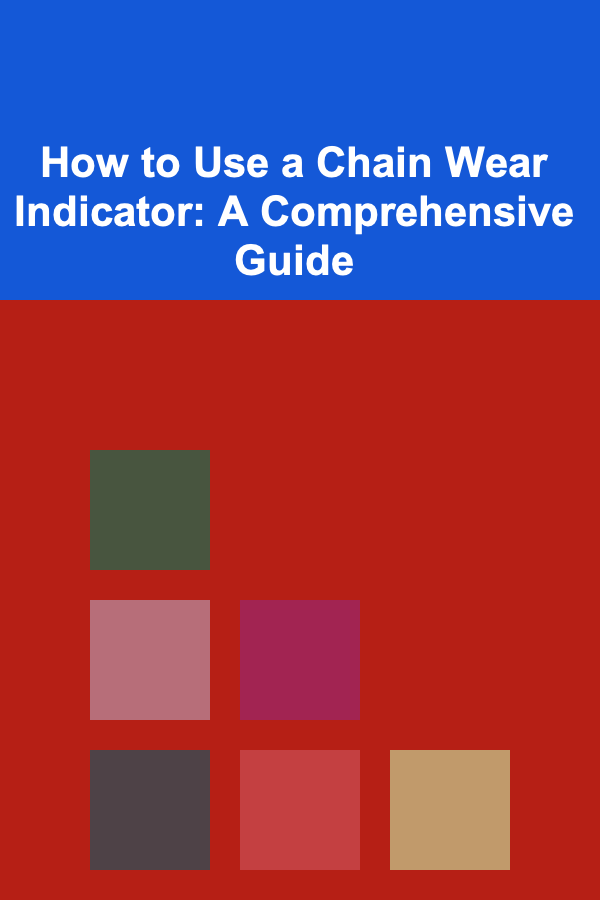
How to Use a Chain Wear Indicator: A Comprehensive Guide
ebook include PDF & Audio bundle (Micro Guide)
$12.99$7.99
Limited Time Offer! Order within the next:

The bicycle chain is a critical component of your drivetrain, responsible for transferring power from your pedals to your rear wheel. Regular maintenance, including proper lubrication and timely replacement, is crucial for optimal performance, efficiency, and the longevity of your other drivetrain parts. One of the most effective tools for determining when to replace your chain is a chain wear indicator. This guide will provide a comprehensive understanding of chain wear, why it's important to address it, the different types of chain wear indicators, how to use them correctly, and other essential aspects of chain maintenance.
Understanding Chain Wear
A bicycle chain is made up of numerous links, each consisting of inner and outer plates connected by pins. Over time, the constant friction and stress from pedaling cause wear at these connection points. Specifically, the holes in the inner and outer plates elongate, and the pins themselves wear down. This elongation is what we measure as chain wear.
A new chain has a pin-to-pin distance of exactly 0.5 inches (12.7 mm). As the chain wears, this distance increases. Chain wear is typically expressed as a percentage -- for example, 0.5% wear or 0.75% wear. These percentages represent the elongation of the chain beyond its original length.
Why is Chain Wear a Problem?
Ignoring chain wear can lead to several problems, some more severe than others:
- Poor Shifting Performance: As a chain wears, it no longer meshes perfectly with the cogs on your cassette and chainrings. This can result in sluggish, imprecise, or even skipped shifts.
- Reduced Efficiency: A worn chain increases friction, robbing you of power and making your pedaling feel less efficient. You'll exert more effort for the same level of performance.
- Premature Wear of Cassette and Chainrings: This is the most significant and costly consequence of neglecting chain wear. A worn chain stretches and starts to "hook" onto the teeth of the cassette and chainrings. This accelerates wear on these components because the chain is no longer sitting properly in the valleys between the teeth. In essence, a worn chain acts like a file, grinding down the teeth.
- Chain Breakage: While less common, a severely worn chain can be more susceptible to breakage, especially under heavy load. This can be dangerous, potentially causing a crash.
Replacing a chain at the right time prevents excessive wear on the cassette and chainrings. Replacing just the chain is significantly cheaper than replacing the entire drivetrain (chain, cassette, and chainrings). Therefore, monitoring chain wear is an investment in the long-term health of your bicycle.
Types of Chain Wear Indicators
There are several types of chain wear indicators available, each with its own method of measuring chain elongation:
- Simple Go/No-Go Tools: These are the most common and affordable type of chain wear indicator. They typically have two prongs or arms. One prong is designed to fit snugly into the chain, and the other prong is marked with a percentage (e.g., 0.75% or 1.0%). The tool is inserted into the chain, and if the marked prong sinks completely into the chain, it indicates that the chain has reached that level of wear. These are easy to use and provide a quick indication of whether the chain needs replacement.
- Digital Chain Wear Indicators: These are more advanced and generally more expensive. They use electronic sensors to measure the exact elongation of the chain and display the reading on a digital screen. They often provide more precise measurements than go/no-go tools.
- Ruler Method: While not a dedicated chain wear indicator, a standard ruler can be used to approximate chain wear. This method involves measuring the distance between 12 links (12 full pitches) of the chain. If the distance exceeds 12 1/16 inches, the chain is considered worn. This is a less precise method, but it can be a useful alternative if you don't have a dedicated chain wear indicator.
- Caliper Method: Using a digital caliper, you can measure the distance between a set number of chain pins. This method is very accurate but requires a high degree of precision and understanding of the chain's original dimensions. It's less commonly used by home mechanics.
For most cyclists, a simple go/no-go tool is sufficient for monitoring chain wear. They are inexpensive, easy to use, and provide a reliable indication of when a chain replacement is necessary.
How to Use a Go/No-Go Chain Wear Indicator
Using a go/no-go chain wear indicator is straightforward. Here's a step-by-step guide:
- Locate a Clean Section of the Chain: Choose a section of the chain that is relatively clean and free from dirt and grime. This will ensure a more accurate reading. Wipe the chain clean with a rag if necessary. Avoid measuring near the chain master link or chainring/cassette interface.
- Insert the First Prong: Place the first prong of the chain wear indicator into a chain link. Ensure that the prong is fully seated into the link, fitting snugly between the inner plates.
- Attempt to Insert the Second Prong: With the first prong securely in place, attempt to insert the second prong into a link approximately 12 links away. Do not force the tool. The tool is designed to rely on gravity to properly sit into the link.
- Interpret the Results:
- If the second prong fits completely into the chain: This indicates that the chain has reached or exceeded the wear percentage marked on the tool. You should replace the chain as soon as possible to prevent further damage to the cassette and chainrings.
- If the second prong does not fit into the chain: This indicates that the chain has not yet reached the wear percentage marked on the tool. You can continue using the chain, but you should check it regularly.
- If the second prong only partially fits: This may indicate that the chain is approaching the wear limit and should be monitored closely. Retest the chain after a few rides.
- Test in Multiple Locations: To ensure an accurate assessment, repeat the measurement in several different locations along the chain. Chain wear can be uneven, so taking multiple readings provides a more representative indication of overall chain condition.
Important Considerations:
- Chain Tension: When using a chain wear indicator, ensure that the chain is under slight tension. This can be achieved by holding the rear wheel and rotating the pedals slightly forward. Too much slack in the chain can affect the accuracy of the measurement.
- Tool Quality: Invest in a good quality chain wear indicator from a reputable brand. Cheaply made tools may not be accurate and could provide misleading results.
- Understand the Markings: Pay attention to the wear percentages marked on the tool. Some tools have a single marking (e.g., 0.75%), while others have multiple markings (e.g., 0.75% and 1.0%). The 0.75% marking is a common recommendation for when to replace a chain, particularly for 10-speed, 11-speed, and 12-speed drivetrains. Waiting until 1.0% wear increases the risk of needing to replace the cassette and chainrings.
Using the Ruler Method to Check Chain Wear
If you don't have a dedicated chain wear indicator, you can use a ruler to get an approximation of chain wear. This method is less precise but can still be helpful. You will need a ruler that measures in inches, preferably one with 1/16th inch markings.
- Locate a Clean Section of the Chain: As with the chain wear indicator, choose a clean section of the chain.
- Measure 12 Links: Align the zero mark on the ruler with the center of a chain pin. Count out 12 full links (12 full pitches) and note the measurement at the center of the 12th pin. It is important to count full links, not partial ones.
- Interpret the Results:
- 12 inches: This indicates a new or nearly new chain.
- 12 1/16 inches: This indicates approximately 0.5% wear. The chain is starting to wear, but replacement may not be immediately necessary.
- 12 1/8 inches: This indicates approximately 0.75% wear. Chain replacement is recommended to prevent excessive wear on the cassette and chainrings.
- 12 3/16 inches: This indicates approximately 1.0% wear. The chain is severely worn, and replacement is essential to prevent further damage to the drivetrain. There is a high probability that the cassette and chainrings are also worn.
The ruler method is a good alternative if you don't have a chain wear indicator, but it is less precise. It's important to be as accurate as possible when measuring and to consider replacing the chain sooner rather than later if you are unsure.
Understanding Wear Percentages and Drivetrain Compatibility
The recommended wear percentage for chain replacement can vary depending on the type of drivetrain you have. Generally, drivetrains with more speeds (e.g., 11-speed, 12-speed) are more sensitive to chain wear than drivetrains with fewer speeds (e.g., 8-speed, 9-speed). This is because the cogs and chainrings on higher-speed drivetrains are narrower and more closely spaced, making them more susceptible to wear from a stretched chain.
- 8-speed and 9-speed Drivetrains: You can often wait until the chain reaches 0.75% to 1.0% wear before replacing it. Due to the wider spacing of the cogs, these systems are often more tolerant of chain wear.
- 10-speed Drivetrains: Replacing the chain at 0.75% wear is generally recommended.
- 11-speed and 12-speed Drivetrains: Replacing the chain at 0.5% to 0.75% wear is highly recommended to prevent accelerated wear on the cassette and chainrings. These drivetrains are very sensitive to chain wear, and neglecting chain replacement can quickly lead to costly drivetrain repairs.
Consult your bicycle manufacturer's recommendations or your local bike shop for specific advice on chain replacement intervals for your drivetrain.
Other Factors Affecting Chain Wear
Besides the amount of riding you do, several other factors can affect the rate of chain wear:
- Riding Conditions: Riding in wet, muddy, or dusty conditions can accelerate chain wear. Grit and debris act as abrasives, increasing friction and wearing down the chain components.
- Lubrication: Proper lubrication is crucial for minimizing chain wear. A dry chain will experience significantly more friction than a well-lubricated chain. Choose a high-quality chain lubricant that is appropriate for your riding conditions and apply it regularly.
- Riding Style: Riding with a lot of torque or frequently shifting under load can put additional stress on the chain, leading to faster wear. Try to anticipate shifts and ease off the pedals slightly when changing gears.
- Chain Quality: Higher-quality chains are typically made from more durable materials and are designed to withstand more wear. Investing in a good quality chain can often be more cost-effective in the long run.
Chain Maintenance Tips
In addition to using a chain wear indicator, the following chain maintenance tips can help extend the life of your chain and drivetrain:
- Clean Your Chain Regularly: Use a chain cleaning tool or a brush and solvent to remove dirt and grime from your chain. A clean chain is a happy chain.
- Lubricate Your Chain Frequently: Apply chain lubricant after each cleaning and whenever the chain starts to sound dry or noisy. Choose a lubricant that is appropriate for your riding conditions.
- Wipe Off Excess Lubricant: After lubricating the chain, wipe off any excess lubricant with a clean rag. Excess lubricant can attract dirt and grime, which can accelerate chain wear.
- Shift Gears Smoothly: Avoid shifting gears under heavy load. This can put unnecessary stress on the chain and drivetrain components.
- Store Your Bike Properly: When storing your bike, keep it in a dry place. Moisture can cause the chain to rust, which can accelerate wear.
Replacing Your Chain
Once you have determined that your chain needs to be replaced, you will need a few tools:
- New Chain: Choose a chain that is compatible with your drivetrain (number of speeds).
- Chain Tool: This tool is used to remove and install chain pins.
- Master Link Pliers (Optional but Recommended): These pliers make it easier to install and remove master links, which are used to connect the ends of the chain on many modern drivetrains.
- Gloves: To keep your hands clean.
Steps for Replacing Your Chain:
- Remove the Old Chain: Using the chain tool, break the old chain. If your chain has a master link, use the master link pliers to remove it.
- Determine the Correct Chain Length: Compare the length of the old chain to the new chain. The new chain should be the same length as the old chain. Alternatively, you can use the "big-big" method. Shift the chain onto the largest chainring and the largest cog on the cassette. Add two links to this length. This will ensure proper shifting.
- Shorten the New Chain (If Necessary): Use the chain tool to remove any excess links from the new chain.
- Install the New Chain: Thread the new chain through the derailleurs and around the chainrings and cassette.
- Connect the Ends of the Chain: If your chain uses a master link, connect the ends of the chain using the master link and master link pliers. If your chain requires a chain pin, use the chain tool to insert and peen the pin.
- Verify Proper Function: Shift through all the gears to ensure that the chain is shifting smoothly and quietly.
If you are not comfortable replacing your chain yourself, take your bike to a local bike shop. They can replace the chain for you and ensure that it is properly installed.
Conclusion
Regularly checking your chain for wear using a chain wear indicator is an essential part of bicycle maintenance. By replacing your chain at the right time, you can prevent premature wear on your cassette and chainrings, saving you money in the long run and ensuring optimal performance and efficiency. Choose the right type of chain wear indicator for your needs, follow the steps outlined in this guide, and keep your chain clean and lubricated. With a little bit of attention, you can keep your drivetrain running smoothly for years to come.

How to Build a Customer Feedback Management Checklist for Cross-Department Collaboration
Read More
How to Choose Pet-Friendly Furniture for Your Home
Read More
How to Conduct a Regular Office Clean-Up Day
Read More
How to Keep Your Home Safe While Working from Home
Read More
How to Start Saving Money on Prescription Medications Without Sacrificing Quality
Read More
How to Use Curtains to Soundproof Your Home Effectively
Read MoreOther Products

How to Build a Customer Feedback Management Checklist for Cross-Department Collaboration
Read More
How to Choose Pet-Friendly Furniture for Your Home
Read More
How to Conduct a Regular Office Clean-Up Day
Read More
How to Keep Your Home Safe While Working from Home
Read More
How to Start Saving Money on Prescription Medications Without Sacrificing Quality
Read More